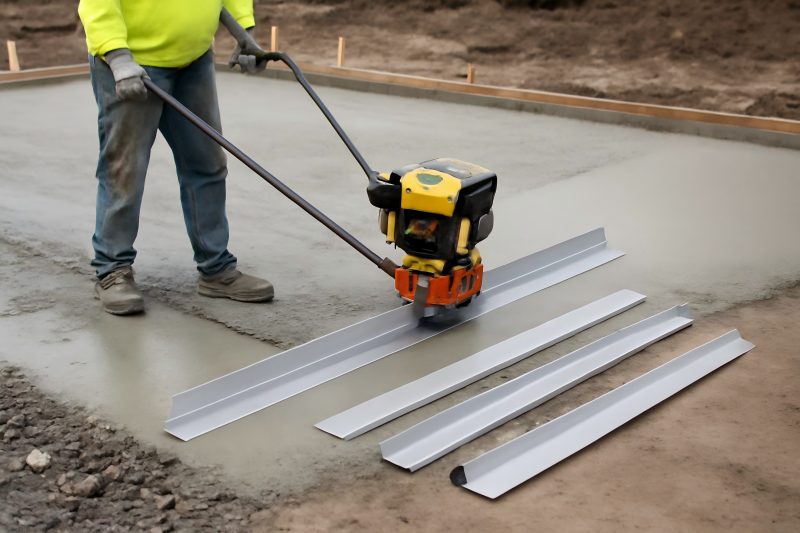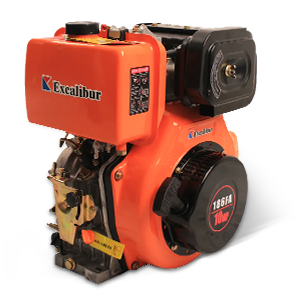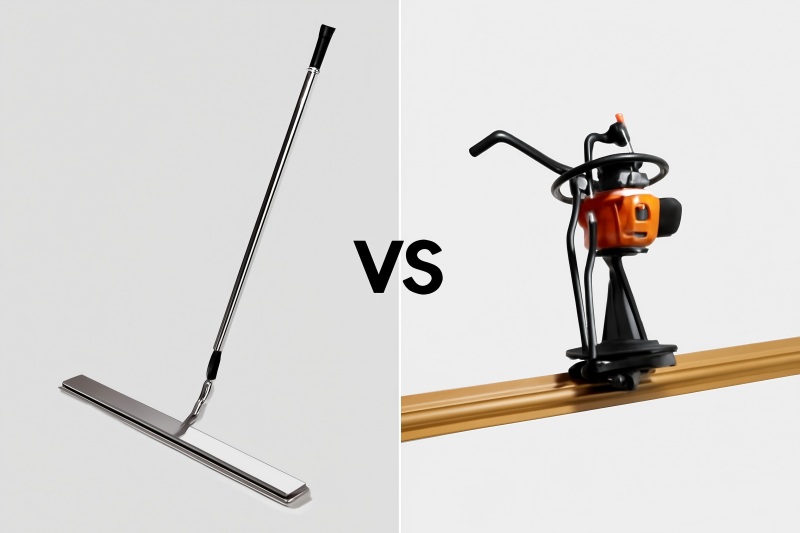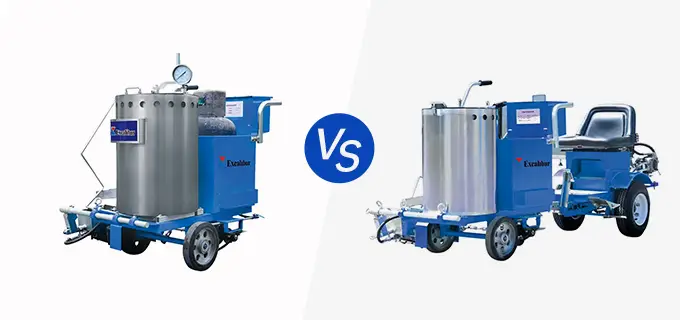Concrete finishing has evolved significantly over the years, and vibrating screeds have become one of the most important tools for contractors seeking faster, flatter, and more uniform slabs. Yet, while the motor or vibration frequency often gets attention, one key part is frequently overlooked: the screed blade itself.
Blade length and thickness directly influence productivity, surface flatness, compaction efficiency, and operator comfort. Choosing the wrong combination can slow down a job, cause inconsistent slabs, or increase worker fatigue. Choosing the right one, however, optimizes both finishing speed and slab quality.
Why the Screed Blade Matters
The blade is the working edge that contacts the concrete. While the motor creates vibration and forward motion, the blade is responsible for:
- Striking off excess concrete
- Transferring vibration into the slab
- Compacting aggregates
- Creating a flat and level surface
- Maintaining consistent forward movement
A poorly selected blade can cause:
- Uneven surfaces
- Ridge lines
- Insufficient compaction
- Operator strain
- Slow progress
- Over-vibration or surface defects
Understanding blade dimensions ensures the vibrating screed delivers professional, consistent concrete finishing.
What Is Blade Length?
Blade length refers to the horizontal span of the vibrating screed blade measured from end to end. Common lengths range from 1.2 m (4 ft) to 6 m (20 ft) depending on tool type and application.
The role of blade length
Blade length determines:
- The width of the concrete pass
- How many workers are needed
- The level of control required
- The ease of maneuverability
- The flatness and smoothness of the surface
A longer blade covers more area per pass but requires more power and experienced handling. A shorter blade provides better detail control but increases job time.
Blade Length Options and Their Applications
Below is a general overview of vibrating screed blade lengths and the project types they are suited for.
Short Blades (4–8 ft / 1.2–2.4 m)
Best for
- Sidewalks
- Driveways
- Small patios
- Narrow pathways
- Tight or obstructed spaces
Advantages
- Easy handling
- Lightweight
- Ideal for beginner operators
- Good for high-detail finishing
Limitations
- Slow for large concrete pours
- Requires more passes
Medium Blades (10–14 ft / 3–4.2 m)
Best for
- Residential slabs
- Garages
- Small warehouses
- General construction sites
Advantages
- Good combination of speed and control
- Efficient for most common jobs
Limitations
- Slightly heavier
- Requires more power
Long Blades (16–20 ft / 4.8–6 m)
Best for
- Large commercial floors
- Industrial slabs
- Warehouses
- Parking lots
- Concrete roadwork
Advantages
- Maximum productivity
- Fewer passes required
- Produces flatter large-area slabs
Limitations
- Heavier and more difficult to maneuver
- Requires high-output engines
- Best handled by experienced operators
What Is Blade Thickness?
Blade thickness refers to the wall thickness of the aluminum extrusion or steel plate used to form the screed blade. Typical thickness ranges include:
- 1.5 mm (light-duty)
- 2.0 mm (medium-duty)
- 2.5–3.0 mm (heavy-duty industrial)
- 5+ mm (reinforced thick blades for large-area screeding)
The role of blade thickness
Thicker blades improve stiffness and reduce flexing. This directly affects:
- Compaction force
- Overall flatness
- Blade longevity
- Vibration transfer efficiency
- Resistance to deformation
However, thicker blades also weigh more, which influences handling and operator comfort.
Thin vs. Thick Screed Blades
Understanding the functional difference between thin and thick blades is essential.
Thin Blades (1.5–2.0 mm)
Advantages
- Lightweight
- Easy to maneuver
- Suitable for small areas
- Less operator fatigue
Best for
- Sidewalks
- Small slabs
- Thin concrete pours
- Low-slump mixes
Limitations
- More blade flexing
- Reduced compaction
- Less suitable for high-volume work
Thick Blades (2.5–5 mm+)
Advantages
- Very rigid and durable
- High compaction efficiency
- Ideal for large pours
- Uniform slab finishing
- Less deformation under stress
Best for
- Commercial floors
- Industrial facilities
- Roads and parking lots
- High-slump or stiff mixes
Limitations
- Heavier
- Requires more experience
- Greater operator fatigue if hand-held
How Blade Length and Thickness Work Together
Blade length and thickness are interconnected. For example:
- A long blade requires greater thickness to maintain rigidity.
- A short blade can function well with thinner construction.
- Using a long, thin blade causes flex, resulting in waves, dips, or inconsistent leveling.
- Using a short, thick blade may be overkill, adding unnecessary weight.
Choosing the wrong combination impacts concrete quality and crew productivity.
Recommended Blade Length vs. Thickness
This table provides general guidelines for choosing blade thickness according to length and job type.
| Blade Length | Typical Thickness | Best For | Notes |
| 4 ft (1.2 m) | 1.5–2.0 mm | Small repairs, sidewalks | Very easy to maneuver |
| 6 ft (1.8 m) | 1.5–2.0 mm | Driveways, patios | Good control for beginners |
| 8 ft (2.4 m) | 2.0 mm | Residential slabs | Balance of stiffness and weight |
| 10 ft (3.0 m) | 2.0–2.5 mm | Garages, small warehouses | Faster coverage with moderate weight |
| 12 ft (3.6 m) | 2.5 mm | Mid-sized projects | Requires more power |
| 14 ft (4.2 m) | 2.5–3.0 mm | Medium commercial slabs | Good rigidity needed |
| 16 ft (4.8 m) | 3.0–4.0 mm | Large commercial slabs | High stiffness prevents flexing |
| 20 ft (6 m) | 4.0–5.0 mm+ | Industrial flooring, roadwork | Requires experienced operators and large engines |
How Blade Flex Affects Concrete Quality
Blade rigidity is essential because flexing creates finish defects, such as:
Washboarding
Wave-like patterns caused by inconsistent vibration transfer.
Dips or Low Spots
Areas where the blade flexes inward and fails to strike off material.
Ridge Lines
Excess concrete pushed toward the blade edges.
Loss of Compaction
Thin, flexible blades reduce downward pressure.
Rigid blades produce:
- Uniform aggregates
- High compaction
- Flatter surfaces
- Fewer finishing passes
- Improved strength and long-term slab durability
Blade Thickness vs. Compaction and Flatness
| Blade Thickness | Compaction Power | Flatness Quality | Best Application |
| 1.5 mm | Low | Medium | Light-duty sidewalks, narrow pathways |
| 2.0 mm | Moderate | Good | Standard residential work |
| 2.5 mm | Strong | Very Good | General construction, moderate slabs |
| 3.0 mm | High | Excellent | Large slabs, commercial floors |
| 4–5 mm | Very High | Industrial Grade | Heavy-duty industrial slabs |

How Concrete Slump Influences Blade Selection
Concrete slump (workability) impacts which blade performs best:
Low slump (stiff mix)
- Requires thicker blade
- More compaction power needed
- Thin blades may chatter or skip
Medium slump (typical mixes)
- Works well with most blade thicknesses
- Best balance for productivity
High slump (wet mixes)
- Thin-to-medium blades acceptable
- Excessive thickness may “plow” the mix
Engine Power and Blade Size Compatibility
The larger and thicker the blade, the more engine vibration force is required. Underpowered screeds cause:
- Slow movement
- Inconsistent compaction
- Excessive operator pushing
- Overheating motors
Typical guidelines:
- Small blades (4–8 ft) → 1–1.5 HP engines
- Medium blades (10–14 ft) → 1.5–2.0 HP
- Large blades (16–20 ft) → 2.0–3.0+ HP
Compatibility ensures smooth forward momentum and consistent slab finish.
Operator Skill and Comfort Considerations
Using a vibrating screed is not just about vibration—controllability matters:
Long, thick blades
- Require more skill
- Produce strong vibration
- Can cause fatigue during long pours
Short, thin blades
- Ideal for beginners
- Very easy to handle
- Lightweight but less productive
Tip:
Professionals often carry multiple blade lengths to match project conditions.
How to Choose the Right Blade for Your Project
Follow this 4-step decision process:
Step 1: Identify the slab size
- Small (<30 m²): Use short, thin blades
- Medium (30–150 m²): Medium-length, mid-thickness blades
- Large (>150 m²): Long, thick commercial-grade blades
Step 2: Check concrete slump
- Low slump → thicker blade
- High slump → thinner blade acceptable
Step 3: Match engine power
Ensure the motor can support the chosen blade length and mass.
Step 4: Consider operator ability
- Hire experienced operators for long blades
- Choose short blades for small, tight, or irregular areas
Real-World Examples
Example 1: Residential Patio (20 m²)
Best blade: 6–8 ft, 2.0 mm thick
Easy to maneuver
Suitable for a small team
Example 2: Warehouse Slab (500 m²)
Best blade: 14–20 ft, 3–5 mm thick
High productivity
Ensures flat, industrial-grade finish
Example 3: Sidewalk Repair
Best blade: 4 ft, 1.5–2.0 mm
Narrow and precise
Final Recommendations
For small contractors
Invest in:
- 6 ft blade (general purpose)
- 10–12 ft blade (larger projects)
For professional concrete finishing teams
Use a range:
- 4 ft (edges and tight areas)
- 8–10 ft (residential work)
- 14–20 ft (commercial and industrial slabs)
For maximum versatility
Choose medium-thickness blades (2–2.5 mm) first and add thick blades later.
Blade length and thickness greatly influence the performance of vibrating screeds. Short, thin blades offer maneuverability and control for small slabs, while long, thick blades deliver high productivity and exceptional flatness for commercial and industrial concrete work. Matching blade size with concrete slump, operator skill, and engine power ensures reliable, high-quality results across all project types.
Whether you’re finishing a small patio or pouring a massive warehouse floor, choosing the right vibrating screed blade can dramatically improve slab quality and job efficiency. With the guidelines and tables provided in this article, contractors can make informed decisions that optimize performance, durability, and productivity on every concrete pour.




